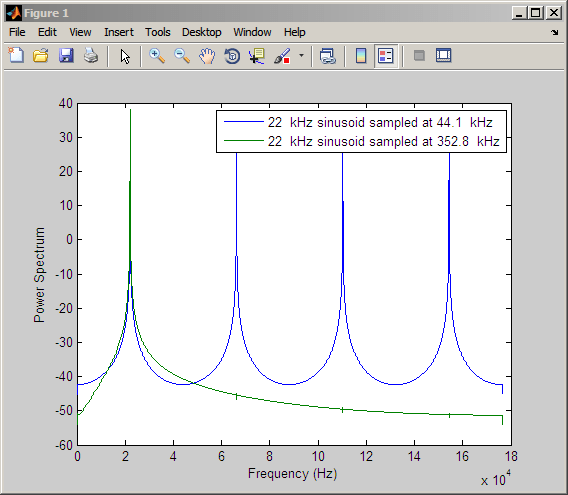mfilt.fftfirinterp
(Removed) Overlap-add FIR polyphase interpolator
mfilt.fftfirinterp has been removed. Use dsp.FIRInterpolator instead. For more details, see Version History.
Syntax
hm = mfilt.fftfirinterp(l,num,bl)
hm = mfilt.fftfirinterp
hm = mfilt.fftfirinterp(l,...)
Description
hm = mfilt.fftfirinterp(l,num,bl) returns a
discrete-time FIR filter object that uses the overlap-add method for filtering input
data.
The input arguments are optional. To enter any optional value, you must include all optional values to the left of your desired value.
When you omit one or more input options, the omitted option applies the default values shown in the table below.
The number of FFT points is given by [bl+ceil(length(num)/l)-1]. It
is to your advantage to choose bl such that the number of FFT points
is a power of two—using powers of two can improve the efficiency of the FFT and
the associated interpolation process.
Input Arguments
The following table describes the input arguments for creating
hm.
Input Argument | Description |
|---|---|
| Interpolation factor for the filter. |
| Vector containing the coefficients of the FIR lowpass
filter used for interpolation. When |
| Length of each block of input data used in the filtering.
|
hm = mfilt.fftfirinterp constructs the
filter using the default values for l, num,
and bl.
hm = mfilt.fftfirinterp(l,...) constructs
the filter using the input arguments you provide and defaults for the argument you
omit.
mfilt.fftfirinterp Object Properties
Every multirate filter object has properties that govern the way it behaves when
you use it. Note that many of the properties are also input arguments for creating
mfilt.fftfirinterp objects. The next table describes each
property for an mfilt.fftfirinterp filter object.
Name | Values | Description |
|---|---|---|
| Reports the type of filter object. You cannot set this
property — it is always read only and results from your
choice of | |
| Vector containing the coefficients of the FIR lowpass filter used for interpolation. | |
| Interpolation factor for the filter. It specifies the amount to increase the input sampling rate. It must be an integer. | |
| Length of each block of input data used in the filtering. | |
|
| Determines whether the filter states are restored to their
starting values for each filtering operation. The starting
values are the values in place when you create the filter if you
have not changed the filter since you constructed it.
|
| Stored conditions for the filter, including values for the interpolator states. |
Examples
Interpolation by a factor of 8. This object removes the spectral replicas in the signal after interpolation.
l = 8; % Interpolation factor hm = mfilt.fftfirinterp(l); % We use the default filter n = 8192; % Number of points hm.blocklength = n; % Set block length to number of points fs = 44.1e3; % Original sample freq: 44.1 kHz. n = 0:n-1; % 0.1858 secs of data x = sin(2*pi*n*22e3/fs); % Original signal, sinusoid at 22 kHz y = filter(hm,x); % Interpolated sinusoid xu = l*upsample(x,8); % Upsample to compare--the spectrum % does not change [px,f]=periodogram(xu,[],65536,l*fs);% Power spectrum of original % signal [py,f]=periodogram(y,[],65536,l*fs); % Power spectrum of % interpolated signal plot(f,10*log10(([fs*px,l*fs*py]))) legend('22 kHz sinusoid sampled at 44.1 kHz',... '22 kHz sinusoid sampled at 352.8 kHz') xlabel('Frequency (Hz)'); ylabel('Power Spectrum');
To see the results of the example, look at this figure.
